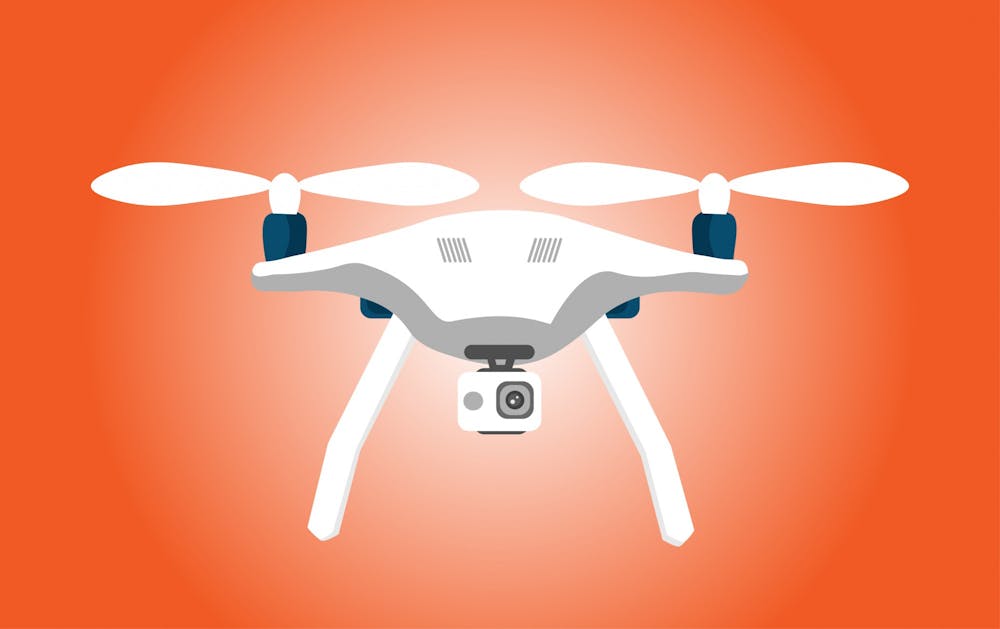Graduate students Archana Pailla, Amanda Williams, Prashant Bolla, Kristen Renee and John Weyenberg met and thought of Phone-A-Drone as a class project but its success connected them and made them consider it for a future enterprise.
During the Fall 2019 semester, as part of a decision making with business analytics course, the group of W.P. Carey graduate students had to come up with a business model and present their ideas within a seven-week time frame.
Phone-A-Drone is a project conducted by the students where anyone could call out the drone company to scope their site and ensure the safety of the buildings.
The idea for Phone-A-Drone first emerged when Weyenberg, who was working at Alliance Bank, realized that a lot of time was spent figuring out the integrity of architecture to determine whether the bank would provide funds.
Weyenberg said he realized it would be convenient if managing sites had drones to oversee the projects and replace the manual labor — shortening a process that could take days into one that would take only hours.
“The process itself is lengthy,” Weyenberg said. “You have to go there, inspect everything and return all the data in a timely manner.”
Once the idea was presented and approved by all members of the group, each student’s unique backgrounds helped to lend to the validity of the project.
Both Pailla and Bolla have backgrounds in engineering and technology; Weyenberg and Renee have financial experience and knowledge of commercial lending; and Williams is adept at marketing.
The students all agreed that their project could not have come to fruition without the unique contribution of each member.
“What one person can come up with can never be as good as what five people come up with when they put their heads together,” Renee said.
Bolla said one of the major challenges when putting the project together was figuring out a way for the drones to work out at a construction site without running out of battery.
According to 3D Insider, the best drones they recommended with the longest battery life lasted 15 to 30 minutes, which Bolla said is not enough time to navigate through a site, scan the surroundings and vacate.
One of the possible solutions the group proposed was to have a truck with a central battery to power the drones.
“If there's a huge community that's being constructed, instead of like sampling houses individually, just have one driver with a truck full of drones, put them in front of houses, they do all their stuff and you can just come pick them up and report to base immediately,” Bolla said.
Another challenge was differentiating themselves in a world where drones are commonplace and showing why their product shines above the rest. According to Bolla, what made Phone-A-Drone unique from other drones was its ability to detect surroundings, which was an idea that came to them courtesy of their professor, Collin Sellman.
“For construction value, you have 3D models right before the construction actually begins,” Bolla said. “So you can grab the initial data with whatever is scanned by the drone to see the differences and that tells you the actual project completion percentage and the doors that are unavailable, stuff like that.”
According to the National Oceanic and Atmospheric Administration, Light Detection and Ranging is, “A remote sensing method that uses light in the form of a pulsed laser to measure ranges (variable distances) to the Earth.”
With the utilization of LIDAR, the group’s drone would not only be able to handle construction sites, but Bolla also figured the drone could be used for mines where it is difficult for people to safely navigate and it would be less risky to send a drone in.
In order to prove that their business theory was possible, Bolla configured a drone to have a visual positioning system and presented their product to the class.
“There was a part in class where it was focusing in on everyone's face, and then he (Bolla) had it do a back-flip,” Williams said. “And it was just cool to not only have this project idea, but actually be able to demonstrate it to our classmates and show that this is something that is truly a tangible product.”
Since the creation of Phone-A-Drone, the graduate students have kept in touch and even plan on possibly taking their class presentation and turning it into a real business. The students said they are strapped for time with juggling grad school, work and a social life, but are considering bringing the project to life after they graduate this semester.
“We work so incredibly well as a team and we genuinely like each other ... for us in some component working together in the future excites all of us,” Williams said, adding, “There's a lot more thought and figuring it out to make things a reality, but definitely a possibility.”
Reach the reporter at slbrinso@asu.edu or follow @Stacy_L_Anders on Twitter.
Like The State Press on Facebook and follow @statepress on Twitter.




